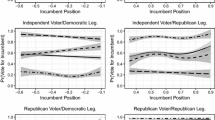Abstract
This paper develops a model of protest voting in which unsatisfied voters may abandon their most-preferred candidate even though he or she has a good chance of winning, in the hope that this signal of disaffection will lead to downstream improvements in that candidate’s performance. We use a spatial model to identify voters whose ideological profile makes protest voting an option, and an expected utility model to identify the conditions under which potential protest voters will in fact use their vote as a signaling device. Aggregate-level data provide suggestive evidence in the argument’s favor.
Similar content being viewed by others
References
Abramson, P. R., Aldrich, J. H., Paolino, P., & Rohde, D. W. (1992). Sophisticated’ voting in the 1988 presidential primaries. American Political Science Review, 86(1), 55–69.
Adams, J., Clark, M., Ezrow, L., & Glasgow, G. (2004). Understanding change and stability in party ideologies: do parties respond to public opinion or to past electoral results. British Journal of Political Science, 34(4), 589–610.
Adams, J., Dow, J., & Merrill, S. (2006). The political consequences of alienation-based and indifference-based voter abstention: applications to presidential elections. Political Behavior, 28(1), 65–86.
Alvarez, M., & Nagler, J. (2000). A new approach for modelling strategic voting in multiparty elections. British Journal of Political Science, 30(1), 57–75.
Black, J. H. (1978). The multi-candidate calculus of voting: application to Canadian federal elections. American Journal of Political Science, 22(3), 609–638.
Blais, A., & Nadeau, R. (1996). Measuring strategic voting: a two-step procedure. Electoral Studies, 15(1), 39–52.
Bowler, S., & Lanoue, D. J. (1992). Strategic and protest voting for third parties: the case of the Canadian NDP. The Western Political Quarterly, 45(2), 485–489.
Budge, I. (1994). A new spatial theory of party competition: uncertainty, ideology and policy equilibria viewed comparatively and temporally. British Journal of Political Science, 24(4), 443–67.
Cain, B. E. (1978). Strategic voting in Britain. American Journal of Political Science, 22(3), 639–655.
Cox, G. (1994). Strategic voting equilibria under the single non-transferable vote. American Political Science Review, 88(3), 608–621.
Cox, G. (1997). Making votes count. Cambridge: Cambridge University Press.
Downs, A. (1957). An economic theory of democracy. New York: Harper.
Franklin, M., Niemi, R., & Whitten, G. (1994). The two faces of tactical voting. British Journal of Political Science, 24(4), 549–557.
Gutowski, W., & Georges, J. (1993). Optimal sophisticated voting strategies in single ballot elections involving three candidates. Public Choice, 77(2), 225–247.
Hinich, M., & Ordeshook, P. (1970). Plurality maximization vs. vote maximization: a spatial analysis with variable participation. American Political Science Review, 64(3), 772–91.
Hirschman, A. O. (1970). Exit, voice, and loyalty responses to decline in firms, organizations, and states. Cambridge: Harvard University Press.
Johnston, R. J., Blais, A., Brady, H. E., & Crete, J. (1992). Letting the people decide: dynamics of a Canadian election. Montreal: McGill-Queen’s University Press.
Kang, W.-T. (2004). Protest voting and abstention under plurality rule elections: an alternative public choice approach. Journal of Theoretical Politics, 16(1), 79–102.
Kellermann, M. (2010). Balancing or signaling? Electoral punishment in sub-national elections. Paper presentation the annual meeting of the Midwest Political Science Association, Chicago, April 2010.
Kselman, D., & Niou, E. (2010). Strategic voting in plurality elections. Political Analysis, 18(2), 227–244.
McKelvey, R. D., & Ordeshook, P. C. (1972). A general theory of the calculus of voting. In J. F. Herndon & J. L. Bernd (Eds.), Mathematical applications in political science IV. Charlottesville: University Press of Virginia.
Meirowitz, A., & Tucker, J. A. (2007). Run Boris run: strategic voting in sequential elections. Journal of Politics, 69(1), 88–99.
Ordeshook, P. C., & Zeng, L. (1997). Rational voters and strategic voting: evidence from the 1968, 1980, and 1992 elections. Journal of Theoretical Politics, 9(2), 167–187.
Palfrey, T. (1989). A mathematical proof of Duverger’s law. In P. C. Ordeshook (Ed.), Models of strategic choice in politics. Ann Arbor: University of Michigan Press.
Riker, W., & Ordeshook, P. (1968). A theory of the calculus of voting. American Political Science Review, 62(1), 25–42.
Rosenstone, S. J., Behr, R. L., & Lazarus, E. H. (1996). Third parties in America: citizen response to major party failure. Princeton: Princeton University Press.
Rosenthal, H., & Sen, S. (1973). Electoral participation in the French fifth republic. The American Political Science Review, 67, 29–54.
Schuessler, A. A. (2000). A logic of expressive choice. Princeton: Princeton University Press.
van der Eijk, C., & Franklin, M. (Eds.) (1996). Choosing Europe? The European electorate and national politics in the face of union. Ann Arbor: The University of Michigan Press.
Author information
Authors and Affiliations
Corresponding author
Rights and permissions
About this article
Cite this article
Kselman, D., Niou, E. Protest voting in plurality elections: a theory of voter signaling. Public Choice 148, 395–418 (2011). https://doi.org/10.1007/s11127-010-9661-2
Received:
Accepted:
Published:
Issue Date:
DOI: https://doi.org/10.1007/s11127-010-9661-2




